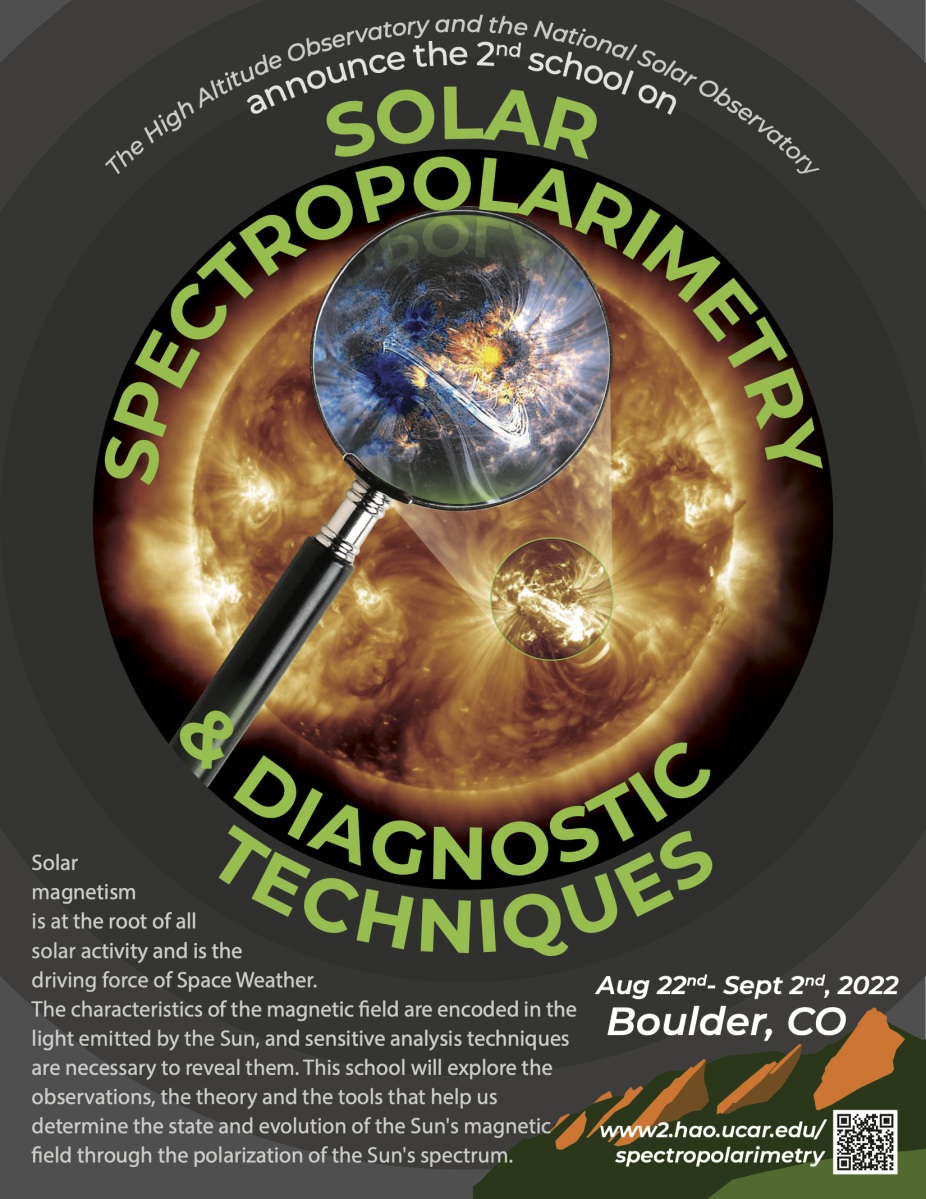Solar Spectropolarimetry and Diagnostic Techniques
The recordings from the workshop are now on HAO's YouTube channel. Here is the playlist. Unfortunately, the first hour of Day 1 and the entirety of Day 4 are missing. We hope that, despite these glitches, the recordings might still be useful to some of you. The playlist is organized by Day of the workshop. We added timestamps for convenient access to the start of each lecture/segment.
The polarized spectrum of the Sun encodes a wealth of information on the thermodynamic and magnetic properties of its atmosphere, which ultimately drive the largest Space Weather phenomena affecting the Earth and near-Earth environment. In order to unveil this valuable information, scientists must perform critically sensitive spectro-polarimetric observations of the Sun, and then carefully reduce, analyze, and interpret the observed data. However, all the aspects involved in this effort (theory, modeling, instrumentation, data analysis) constitute a highly specialized craft, which is notoriously difficult to master.
This two-week school aims at presenting a comprehensive overview of the field of solar spectropolarimetry, and the various tools and methods necessary for decoding the polarization of the solar spectrum.

Poster for Solar Spectropolarimetry and Diagnostic Techniques Workshop
This school will take place in 2022, in Boulder, Colorado. The organization will (partially or fully) support travel and accommodation costs for the students. This is possible thanks to our sponsors: the High Altitude Observatory of NCAR, and the National Solar Observatory.
Approximately 25 participants (domestic and international) will be selected through a competitive process. The school organization will (at least partially) support participants to cover travel, accommodation, and per diem costs during the school. Application details will be available in due course.
Everybody is welcome to apply, however, applications from graduate students and early career scientists working in the field of Solar Physics will be given priority. A minimum of 15 spots will be reserved for domestic participants.
INTENDED AUDIENCE
This school is designed for people who want to delve into the field of spectropolarimetry and learn to carry out spectral line inversions of photospheric and chromospheric (and some coronal) spectra.
- If you are a solar physicist that doesn't know anything about spectropolarimetry but would like to learn what it's all about, this school is for you.
- If you use an inversion code as a black box for your data analysis, but you'd like to learn the underlying theory, physical processes and how inversions actually work, then this school is for you.
- If you have an understanding of the theory of polarized radiative transfer but you'd like to learn about the instrumentation used to acquire the observations and the limitations that arise from the quirks of the data, this school is for you.
- If you have used a Milne-Eddington inversion code in the past, but you'd like to be able to extract more information from your data (thermodynamical properties and atmospheric stratification), then this school is for you.
STRUCTURE OF THE SCHOOL
The first week of the school intends to equip the participants with the basic knowledge of how polarization is produced in the Sun and measured with our instruments. We will delve into the theory of radiative transfer (in Local Thermodynamical Equilibrium or LTE) to understand how the polarized light is actually generated and modified as it propagates through the Sun’s atmosphere, and at the same time we will describe the typical optical devices and instrumentation techniques that enable the measurement of the Sun’s polarized spectrum. The theory will be interlaced with hands-on tutorials on spectral line inversions with the LTE code SIR. With this tutorial, participants will learn how the theoretical and modeling concepts acquired in this week's theoretical lectures are used in practice to extract information from observations about the physical conditions of the Sun’s atmosphere.
In the second week, the theoretical lectures will address the complexities of non Local Thermodynamical Equilibrium (non-LTE) radiative transfer. We will present two different non-LTE spectral-line inversion codes (DeSIRe and HAZEL2), that enable diagnostics of a variety of spectral lines formed under non-LTE conditions. These guided tutorials involve many hours of hands-on activities, with the goal of developing a working understanding of these software packages and their use for the analysis of spectropolarimetric observations. We will populate this website with a description of the three inversion codes and links to download them in due course.
The school will rely on lectures as well as computer lab tutorials taught by leading world experts. The experience will not only offer the participants the opportunity to dive into the field of spectropolarimetry, but will also enable them to develop a network of connections with fellow students, experts, and mentors alike.
For further information please email Rebecca Centeno (rce at ucar dot edu).
ORGANIZING COMMITTEE
Rebecca Centeno (HAO/NCAR)
Roberto Casini (HAO/NCAR)
Gianna Cauzzi (NSO)
Han Uitenbroek (NSO)
Jen Ditsler (NSO)
Sheryl Shapiro (HAO/NCAR)
As of March 1 2022, all NCAR visitors, students and guests are required to be fully vaccinated prior to accessing UCAR/NCAR premises.